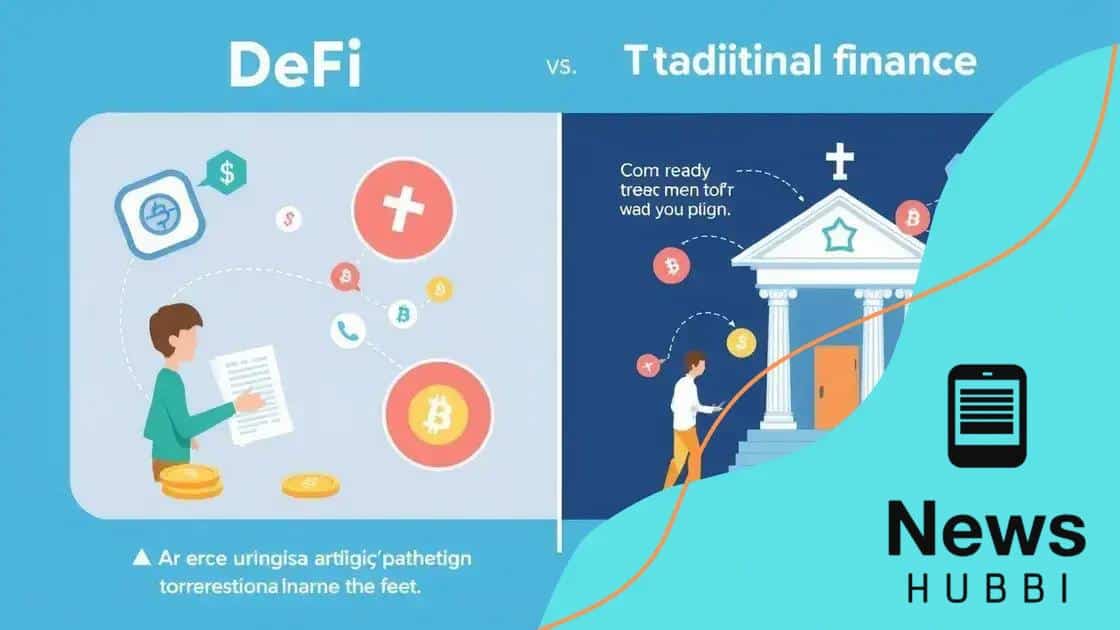The rise of decentralized finance (DeFi) applications

Anúncios
The rise of decentralized finance (DeFi) applications is transforming financial services by offering lower fees, increased accessibility, and more control over assets without relying on traditional banks.
The rise of decentralized finance (DeFi) applications is changing the landscape of finance as we know it. But what does this mean for you? Let’s dive into how these innovative solutions reshape our financial interactions.
Anúncios
Understanding decentralized finance: A primer
Decentralized finance, or DeFi, is reshaping the way we interact with money. This innovative approach offers new opportunities and challenges for everyday users and financial institutions alike. By leveraging blockchain technology, DeFi applications enable users to lend, borrow, and trade without relying on traditional banks.
What Is DeFi?
DeFi refers to a category of financial services that operate on decentralized networks. These platforms eliminate intermediaries, allowing users to transact directly with one another. This not only reduces costs but also increases access to financial services for people who may have been excluded from the traditional banking system.
Key Features of DeFi Applications
- Transparency: All transactions are recorded on a public blockchain, making the system open and verifiable.
- Accessibility: Anyone with internet access can participate, regardless of geographical location.
- Security: Decentralization reduces the risk of single points of failure, enhancing overall security.
- Programmability: Smart contracts automate processes and execute transactions based on pre-defined conditions.
These features are driving the growth of DeFi. Many users appreciate the lower fees and improved control over their finances. However, adopting DeFi applications also requires understanding the risks involved, such as possible volatility and regulatory uncertainties. As we explore this new landscape, it becomes increasingly important to stay informed and engaged with the changes taking place.
Anúncios
In summary, understanding decentralized finance is essential for anyone looking to navigate the modern financial landscape. As these applications continue to evolve, they will likely play a significant role in shaping the future of finance.
Key benefits of DeFi applications

The rise of decentralized finance (DeFi) applications brings numerous advantages for users looking for alternatives to traditional banking systems. One of the most significant benefits is lower transaction fees, which often result from eliminating intermediaries. This shift allows users to keep more of their money and eliminates hidden fees associated with conventional financial services.
Enhanced Accessibility
DeFi applications are accessible to anyone with an internet connection, making financial services available to unbanked and underbanked populations worldwide. This democratization of finance empowers individuals who may not have had access to banking services before.
Control Over Assets
With DeFi, users have complete control over their assets. Traditional banking systems often require trust in banks to manage funds. However, DeFi platforms utilize smart contracts, which execute transactions automatically based on preset terms. This transparency and automation build user confidence.
Opportunities for Passive Income
Investors can earn passive income through various DeFi applications. For instance, by providing liquidity to decentralized exchanges (DEXs), users receive liquidity provider (LP) tokens, which can earn rewards. Additionally, users can lend their assets in exchange for interest, creating new income streams.
- Yield farming: Users can maximize returns by moving assets between platforms to find the best rates.
- Staking: Some DeFi protocols offer rewards for locking up tokens, contributing to network security.
- Liquidity provision: Users can earn fees by contributing to trading pools.
Despite these advantages, using DeFi applications comes with risks, such as smart contract vulnerabilities and market volatility. However, understanding these benefits can help users make informed decisions and take advantage of the evolving financial landscape.
Challenges facing DeFi platforms
While decentralized finance (DeFi) applications offer exciting benefits, they also come with a unique set of challenges. Users must navigate these hurdles to fully utilize the potential of DeFi platforms. One primary challenge is the potential for smart contract vulnerabilities, which can lead to significant financial losses if exploited by malicious actors.
Market Volatility
Another challenge is the inherent market volatility associated with cryptocurrencies. Prices can fluctuate wildly, affecting the value of assets held in DeFi platforms. This unpredictability can deter hesitant investors, making them wary of participating in these innovative services.
Regulatory Uncertainty
Regulatory frameworks surrounding DeFi are still evolving. Governments worldwide are trying to determine how to treat these platforms under existing laws. This regulatory uncertainty can create risks for users and developers alike, as changes may impact the operation and legality of certain DeFi applications.
Liquidity Issues
Some DeFi platforms experience liquidity issues, meaning there may not be enough users to facilitate seamless trading or lending. This can lead to delays or increased slippage in transactions, making it difficult for users to execute trades at desired prices. Users must be aware of where liquidity is abundant and where it may be lacking to avoid potential losses.
- Smart contract audits: Conducting thorough audits helps identify and resolve vulnerabilities before deployment.
- Diversification: Users can protect themselves by diversifying assets across multiple DeFi platforms.
- Staying informed: Keeping up with regulatory developments can help users adapt to changes that may affect their investments.
By understanding these challenges, users can better prepare themselves and navigate the complex landscape of decentralized finance more effectively.
Comparing DeFi and traditional finance

Comparing decentralized finance (DeFi) to traditional finance reveals significant differences that can affect how people manage money. The most notable difference is the use of blockchain technology in DeFi, which creates a transparent and secure way to handle transactions. In contrast, traditional finance relies on centralized institutions that can impose fees and regulations.
Control Over Funds
In the DeFi space, users have complete control over their assets. This empowers individuals to manage their finances without intermediary approval. Traditional finance, however, often requires reliance on banks to access and control funds, which can lead to delays and limitations due to banking hours or policies.
Accessibility
Accessing financial services through DeFi is available to anyone with an internet connection. This is a critical advantage for users in underserved regions. In traditional finance, access often depends on having a bank account or credit history, which many people lack.
Fees and Costs
Cost efficiency is another area where DeFi shines. Users often pay lower fees compared to those charged by traditional banks. This is because DeFi eliminates intermediaries, reducing overall transaction costs. Traditional financial systems, on the other hand, can charge high fees for account maintenance, transfers, and other services.
- Transaction Speed: DeFi transactions can occur in minutes, while traditional finance may take days.
- Regulation: DeFi operates in a less regulated environment, offering flexibility but also potential risks.
- Innovation: DeFi is constantly evolving, introducing new services, while traditional finance can be slower to adapt.
The landscape of finance is shifting, and understanding the differences between DeFi and traditional finance is essential for making informed decisions about investments and financial strategies.
The future of DeFi in a digital economy
The future of decentralized finance (DeFi) in a digital economy looks promising and full of potential. As technology evolves, the adoption of DeFi applications is likely to increase, offering more people access to financial services. This shift toward decentralization enables individuals to control their assets without relying on traditional banking systems.
Integration with Traditional Finance
Many experts believe that DeFi will begin to integrate with traditional finance systems. This integration may take the form of hybrid models, where users can enjoy the benefits of both worlds. For example, individuals might access DeFi services for lending while still having their accounts at traditional banks.
Increased Innovation
Innovation is at the heart of DeFi. As developers continue to explore new ideas, we can expect more advanced financial products to emerge. New solutions will likely address current challenges such as security and user experience, making DeFi even more attractive to the general public.
Focus on Regulation
As DeFi grows, regulators will increasingly pay attention. It is likely that appropriate regulations will be established to ensure user protection and market integrity. A balanced regulatory environment can foster growth while keeping risks in check.
- Global Financial Inclusion: DeFi has the potential to provide financial services to underserved populations worldwide.
- Interoperability: Future DeFi platforms will likely be able to interact seamlessly with one another, enhancing user experience.
- Environmental Sustainability: Efforts may be made to make DeFi applications more energy-efficient, appealing to eco-conscious users.
In summary, the future of DeFi is bright, filled with opportunities for growth and transformation within the digital economy. As innovations continue to unfold, users around the world may benefit from more equitable and accessible financial systems.
FAQ – Frequently Asked Questions about DeFi Applications
What are decentralized finance (DeFi) applications?
DeFi applications are financial services built on blockchain technology, allowing users to lend, borrow, trade, and earn interest without traditional banks.
How do DeFi platforms differ from traditional financial systems?
DeFi platforms operate without intermediaries, offering lower fees, greater accessibility, and more control over personal assets compared to traditional finance.
What risks should I be aware of when using DeFi?
Users should be cautious of smart contract vulnerabilities, market volatility, and regulatory uncertainties associated with DeFi applications.
What is the future outlook for DeFi in the digital economy?
The future of DeFi looks promising, with expected growth in innovation, integration with traditional finance, and a focus on regulatory clarity.





